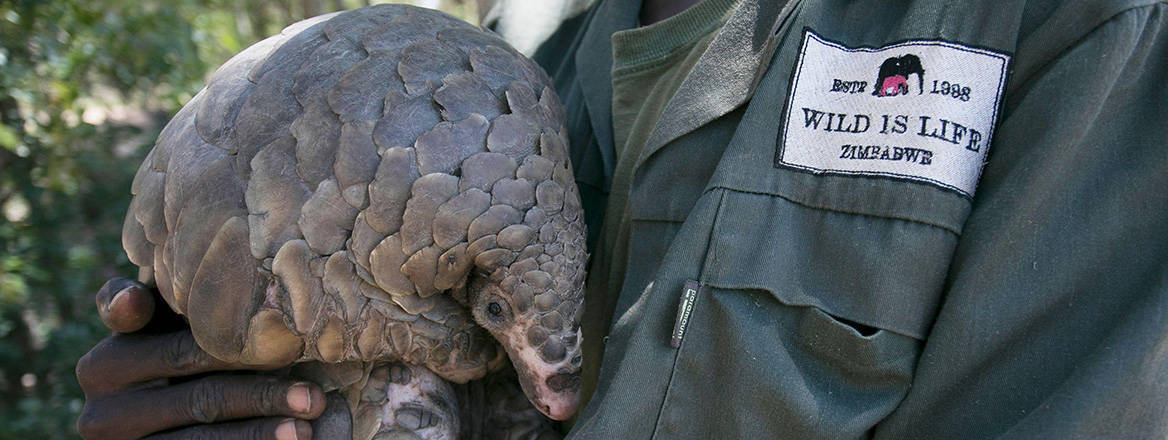Evolve or Perish? Global Action on Illegal Wildlife Trade
Ten years since 46 countries and 11 international organisations committed to act together to bring illegal wildlife trade to an end, is a strategic rethink and wholesale reinvigoration of the collective response required?
Over the past decade, an unprecedented level of funding has been committed to disrupting illegal wildlife trade (IWT) globally. Such investment has come alongside a pronounced increase in political attention to the issue, thanks to royal and other high-profile global initiatives. This marks a key shift: prior to the first high-level London Conference on IWT in 2014, global recognition of the issue was limited, responses were under-funded and disjointed, and perpetrators enjoyed near-total impunity for their crimes. Iconic species such as elephants faced acute poaching threats, with population numbers collapsing in key locations.
Over a decade, our collective endeavours have driven IWT up policy agendas and established a burgeoning global counter-IWT funding and implementation architecture. Enabling large-scale programming worldwide, such a radical transformation in thinking and action around a single crime has seen few parallels across other illicit markets. Tangible results have been seen for some species, resulting from supply and demand-side action. Yet fundamental challenges remain: 10 years since global signatories first gathered in London, and despite the scale of investment, our collective impact on the overarching threat has been limited.
Notably, in 2024, the UN Office on Drugs and Crimes (UNODC) stated that current evidence ‘gives no confidence that wildlife trafficking overall is being substantially reduced’. In particular, ongoing capacity issues, entrenched corruption, intelligence gaps and a lack of coordination have limited long-term impact, leaving in place the criminal incentives fuelling this lucrative illicit market. Commonly used metrics of counter-IWT action – such as arrests and seizures – have proven inadequate, with past efforts failing to dent the health of this resilient criminal economy. This is despite the string of individual enforcement successes claimed by implementers over the decade.
Today, the diversity, scale and geographic scope of trafficking activity are extensive, serving an array of end-use sectors. While the elephant poaching crisis of the 2000s–10s has been contained in a number of African range states, the breadth of the issue has grown ever-clearer as enforcement has failed to keep pace with trafficking activity across numerous species groups. Illustrating this point, from 2015–21, UNODC has documented seizures in 162 countries and territories, comprising 16,000 tons of wildlife – a full 13 million items – affecting 4,000 animal and plant species.
In this climate, progress on global targets has been limited. As noted by UNODC, current estimates ‘give no reason for confidence that SDG target 15.7 [to end trafficking in protected species] is on track to be met by 2030’. Nor have high-level global meetings changed facts on the ground: while legislation has tightened, enforcement action has ramped up and IWT is a higher priority for business, the global ambition seen in 2014 has not yet been realised. This ambition saw London Conference signatories agree commitments ‘to act together to bring … [IWT] to an end’. Ten years on, this lofty goal remains unmet.
Analysing the Report Card
Interventions over the decade have focused on a range of areas. These include bolstering legislation, strengthening law enforcement, developing sustainable livelihoods and reducing demand for IWT products. Further efforts have sought to disrupt trafficking business models, with an influx of professionals with skillsets outside conservation science – from banking to asset recovery – presenting a welcome shift. Meanwhile, in-depth research has generated more data on IWT than ever before and a rich literature on key aspects of the threat and response.
Inadequate practical focus has been placed on systemic corruption as an enabler, with low levels of prosecutions of complicit official actors across the chain
While valuable work has been conducted, a strategic balance between these efforts has often been left wanting. Beyond direct protected area management, funding has often focused disproportionately on bolstering law enforcement, based on a (false) assumption that such activity equates automatically to impact.
At times, such a focus has crowded out other areas. Across Rounds 1–6, for example, the UK’s IWT Challenge Fund supported more law enforcement projects (73) than all other intervention categories combined. While data by objective is available only to Round 6, demand reduction projects received least support, despite their strategic importance to altering underlying criminal incentive structures. Such a pattern of (under-)prioritisation appears mirrored across the wider donor community.
While closely linked to the quality of applications, such imbalances point to a lack of coordination across the counter-IWT space. Despite the 2014 commitment of signatories to act together on IWT – and despite the delivery of valuable work in key locations – incoherence, gaps and duplication have often marked the last decade of action. Here, foundational challenges include a lack of integration, dialogue and strategic coordination among donors, and a counter-IWT implementation landscape marked by fierce competition for funds.
A disjointed financing and programming landscape has in turn allowed imperfect (at times extractive) intervention modalities to thrive. International NGOs with access to donor funds have come to dominate delivery models, at times passing a minimal share of resourcing to local partners for vital ground-level work. Other problematic dynamics have emerged: the prevailing enforcement support model has at times seen NGOs assume inherently governmental functions – raising issues around mandates, incentive structures and capabilities across this sensitive area of programming.
A lack of coordination can create other problems. Where legislation is bolstered, for example, but investigative and prosecutorial capacity (across complex transnational cases) remains unable to touch high-level actors, the skewed application of harsh penalties to subsistence actors risks aggravating existing drivers of IWT activity. Meanwhile, inadequate practical focus has been placed on systemic corruption as an enabler, with low levels of prosecutions of complicit official actors across the chain. A stronger focus on the issue and greater transparency in the sharing of key data – from permit applications to wildlife management licenses – are needed for progress in this area.
A final challenge has come as focus on IWT has ramped up disproportionately to related criminal markets – leading, at times, to siloed thinking and action. A lack of clarity, for example, on how far London and other commitments should apply to illegal fishing (among other areas) has risked action on IWT occurring in a vacuum. In parallel, the absence of an overarching vision of how to obtain strategic impact for the environment appears in the under-prioritisation of unsustainable legal trade. With ongoing gaps in the ability of CITES to address unsustainable exploitation of listed species for international trade, the focus on IWT can only achieve so much.
Charting a New Course?
These realities – and a pronounced downward trend in funding for the sector in recent years – point to a need for deeper thinking around the effectiveness of the current response. This was a journey the sector should have been on already, but one that has grown more urgent as aid pots are slashed and the status quo is fundamentally undermined. Indeed, a looming collapse of the system could now offer a form of shock therapy – a reset opportunity that the sector must seize. Doing so may be challenging, however, as implementers hunker down and attempt to maintain business continuity.
Yet it is crucial, now more than ever, to assess the record of 10 years of sustained investment and ask what alternatives exist to the dominant counter-IWT system. For some, a shift away from the current donorship model may not be a negative development – although the chaotic nature of this shift, as led by the US, is clearly damaging. Here, calls for a paradigm shift in the way we respond to IWT are highly relevant, with the gaps in the prevailing approach – and the need for a move to locally led, adequately contextualised solutions – increasingly understood.
On this point, a potential opportunity lies in the catalysation of extant local capacity to lead key aspects of IWT intervention amid the current constrained global climate. At the same time, a shift from a mainly reactive approach to a more proactive focus on crime prevention is needed as today’s conservation crisis deepens – moving beyond a criminal justice focus once crime is committed. A greater emphasis on forecasting (and addressing) demand and displacement-driven trends is also required, based on improved early-warning systems.
Often, outputs rather than outcomes are celebrated, many (arrests and seizures) stopping short of conservation impact
In addressing these issues, stronger coordination is needed across a fragmented system. Here, contractions in today’s funding landscape offer hope for deeper synergies as implementers turn to partnership working to consolidate interventions and grow more competitive. This is much needed: whilst coordination has improved in recent years, it often remains limited to superficial deconfliction of calendars and trainees. This owes to the under-funding and delegation of coordination by donors to grantees, despite obvious perverse incentives for implementers in competition for funds.
In this context, more active and granular deconfliction of future allocations is needed, with donors working to identify synergies and potential overlaps early. Coordination among implementers must then be incentivised and resourced throughout delivery. In parallel, greater policy attention and research is required around the question of how best to practically bolster coordination across key aspects of counter-IWT programming – with support for such efforts offering strong potential system-wide return on investment.
All this links closely to the need to fundamentally reconsider what we label ‘success’ in the counter-IWT sector. Often, outputs rather than outcomes are celebrated, many (arrests and seizures) stopping short of conservation impact. Even where crime-based metrics consider convictions as measures of the end-to-end working of relevant criminal justice systems, key issues remain around applying counter-IWT interventions to address biodiversity loss. The donor community must demand more – through rigorous evaluation of counter-IWT programming, sustained investment in evidence building, and the development of tailored metrics for the sector.
Alongside this, a more holistic approach to IWT must be adopted – breaking down siloes and better accounting for convergence with wider environmental challenges. Here, the centrality of the issue to the triple planetary crisis must be recognised – intertwined as this is with climate change, biodiversity loss and pollution as threats to the foundations of prosperity, peace and security. In accounting for these links, opportunities for engagement must be seized across wider multilateral processes – including, most proximately, the 2025 UN Climate Change Conference in Belém.
For much of the past ten years, IWT has been addressed in a political climate conducive to high levels of funding and goodwill to address the issue. Today, the threat must be tackled in a fundamentally altered strategic context. Amid the current profound shocks to the system, how the counter-IWT community positions itself, embraces unanswered questions over evidence and impact, builds new political alliances and strategically engages other sectors will determine the results that can be achieved.
© RUSI, 2025.
The views expressed in this Commentary are the author's, and do not represent those of RUSI or any other institution.
For terms of use, see Website Ts&Cs of Use.
Have an idea for a Commentary you’d like to write for us? Send a short pitch to commentaries@rusi.org and we’ll get back to you if it fits into our research interests. View full guidelines for contributors.
WRITTEN BY
Cathy Haenlein
Director of Organised Crime and Policing Studies
Organised Crime and Policing
- Jim McLeanMedia Relations Manager+44 (0)7917 373 069JimMc@rusi.org



